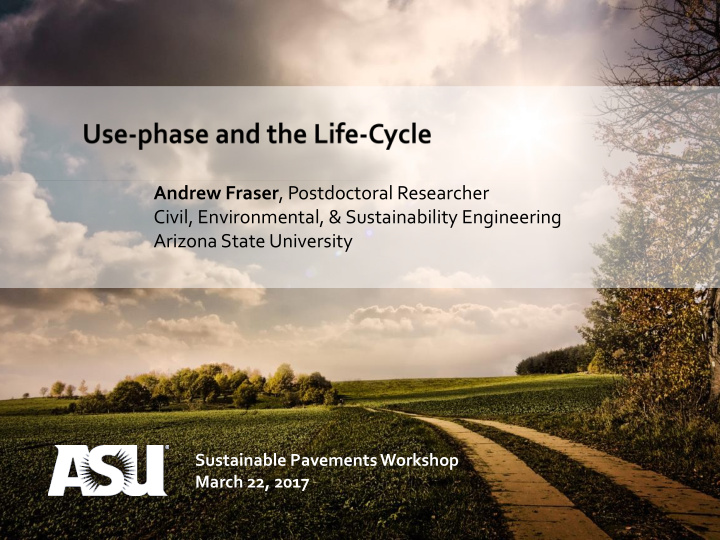



Andrew Fraser , Postdoctoral Researcher Civil, Environmental, & Sustainability Engineering Arizona State University Sustainable Pavements Workshop March 22, 2017
Identifying opportunities to improve the environmental performance of products and production systems Inform and guide decision makers as part of the strategic planning process Identify trade-offs in decision making across all life-cycle stages and multiple environmental and other indicators
Renewable Eutrophi- Energy Use cation Resource Non- Tropospheric Use Renewable Ozone Climate Ozone Acidi- Emissions Depletion fication Change Non Toxicity Respiratory Carcinogenic Carcinogenic Fresh Water Water Ecotoxicity Use Non- Waste Hazardous hazardous
Greenhouse Gas Emissions (mmt CO 2 e) 16 20 10 12 14 18 2 4 6 8 - 1950 1954 1958 1962 1966 1970 1974 1978 1982 1986 1990 1994 1998 2002 2006 2010 Roadway Construction Roadway Maintenance
Automobile Life-cycle Emissions per Passenger Mile Traveled 0 100 200 300 400 Greenhouse Gases (grams) Particulate Matter (<10 μ m, milligrams) Sulfur Oxides (milligrams) Vehicle Active Operation Vehicle Manufacturing Vehicle Maintenance Vehicle Insurance Infrastructure Construction Infrastructure Operation Infrastructure Maintenance Infrastructure Parking Infrastructure Insurance Fuel Production Chester and Horvath, 2009, Environmental assessment of passenger transportation should include infrastructure and supply chains, Environmental Research Letters 4(2), doi:10.1088/1748-9326/4/2/024008
Millard-Ball and Schipper, 2010, Are We Reaching Peak Travel? Trends in Passenger Transport in Eight Industrialized Countries, Transport Reviews, doi:10.1080/01441647.2010.518291
Automobile Life-cycle Emissions per Passenger Mile Traveled 0 100 200 300 400 Greenhouse Gases (grams) Particulate Matter (<10 μ m, milligrams) Sulfur Oxides (milligrams) Vehicle Active Operation Vehicle Manufacturing Vehicle Maintenance Vehicle Insurance Infrastructure Construction Infrastructure Operation Infrastructure Maintenance Infrastructure Parking Infrastructure Insurance Fuel Production Chester and Horvath, 2009, Environmental assessment of passenger transportation should include infrastructure and supply chains, Environmental Research Letters 4(2), doi:10.1088/1748-9326/4/2/024008
Santero et al. 2011, Methods, Impacts, and Opportunities in the Concrete Pavement Life Cycle, MIT Concrete Sustainability Hub
Santero et al. 2011, Methods, Impacts, and Mechanistic Empirical Pavement Design Guide (MEPDG) model. Advanced designs Opportunities in the Concrete Pavement tools, such as MEPDG, can help to define when M&R trigger levels are reached. Life Cycle, MIT Concrete Sustainability Hub
200 Greenhouse Gas Emissions (mmt CO 2 e) 180 160 140 120 Vehicle Tailpipe 100 Roadway Maintenance 80 Roadway Construction 60 40 20 - 1950 1955 1960 1965 1970 1975 1980 1985 1990 1995 2000 2005 2010
Vehicle emissions resulting from the use of the infrastructure are potentially an order(s) of magnitude greater than the cumulative construction and maintenance emissions burden A portion of these emissions can be attributed to pavement attributes and construction and maintenance activities
Work Zone Congestion • Construction, maintenance, and rehabilitation activities will cause changes to traffic flow, traffic speed, delay, and potentially increase VMT due to diversions • Off-peak activities can reduce these impacts but may be partially offset by emissions associated with lighting for nighttime construction. • Pavement roughness, macro texture, and Rolling Resistance structural response affect vehicle fuel economy and have a significant environmental impact • In some cases rough pavement texture can function as a safety feature. In such instances, a tradeoff is made between safety and vehicle emissions.
Mg CO 2 e per lane-km Santero and Horvath, 2009, Global Warming Potential of Pavements, Environmental Research Letters 4, doi:10.1088/1748-9326/4/3/034011
Step 0: Demolition and Removal of Existing Infrastructure What are the existing What is done with old conditions and what material? How far is it equipment is required? transported? Step 1: Construction of New Infrastructure 1) Material Selection • Does Texas DOT and City of El Flexible vs. Rigid Pavement Infrastructure Design Paso use recycled materials in pavements? 2) Cross Sectional Design • What is the source of the Expected Traffic Loadings and vs. Design Life materials? How far is it transported? • Are there any design elements unique to El Paso or Texas? Step 2: Maintenance of Infrastructure What are the maintenance practices of How does the maintenance requirement change from the TX-DOT and the City of El Paso? old infrastructure to the new?
Renewable Eutrophi- Energy Use cation Resource Non- Tropospheric Use Renewable Ozone Climate Ozone Acidi- Emissions Depletion fication Change Non Toxicity Respiratory Carcinogenic Carcinogenic Fresh Water Water Ecotoxicity Use Non- Waste Hazardous hazardous
Renewable Eutrophi- Energy Use cation Resource Non- Tropospheric Use Renewable Ozone Climate Ozone Acidi- Emissions Depletion fication Change Non Toxicity Respiratory Carcinogenic Carcinogenic Fresh Water Water Ecotoxicity Use Non- Waste Hazardous hazardous
Some impacts are global – Climate Change Other impacts are Local- Respiratory
Network Scale Project Scale = X Vehicle Activity Emission Factors Emissions MOVES Link-Level Average Speed Total = X Link-Level VMT Speed-Based EF Emissions
Preliminary findings suggest that traffic flow improvements at the project level do not necessarily translate into emission benefits across a larger network ▪ Combination of induced demand, downstream network capacity constraints, and UE vehicle rerouting lead to additional congestion and increased VMT Increased Emissions
Changing pavement systems to improve environmental sustainability is a complex process LCA can help guide the decision making process regarding changes to policies and practices to reduce impacts of pavements LCA as a method is data driven and there are currently limited tools available. FHWA Tech Brief – Life Cycle Assessment of Pavements (FHWA-HIF-15-001 , October 2014) FHWA Full Report - Pavement Life Cycle Assessment Framework (FHWA-HIF-16-014, July 2016)
Questions? andrew.fraser@asu.edu
Greenhouse Gas sensitivity to ten most influential parameters on six urban roadway classifications Santero et al. 2011, Methods, Impacts, and Opportunities in the Concrete Pavement Life Cycle, MIT Concrete Sustainability Hub
Clear need for life-cycle assessment Upfront ▪ Materials investments can lead to massive ▪ Construction societal economic and environmental ▪ Use gains. ▪ End-of-life Traveled way makes up only a fraction of surface area
Materials & Methods ▪ Wearing Course ▪ Subbase ▪ Shoulders ▪ Embankments Roughly 90 life-cycle components Indicators ▪ Costs ▪ VOC ▪ Energy ▪ PM ▪ Water ▪ SO2 ▪ CO2 ▪ CO ▪ NOx
Recommend
More recommend